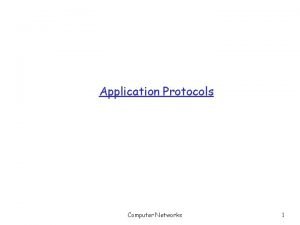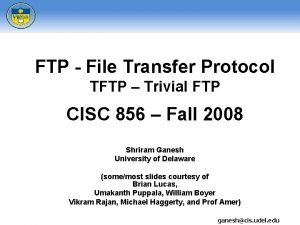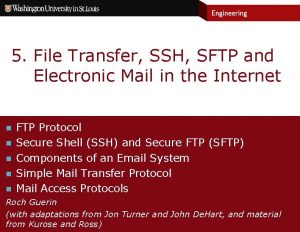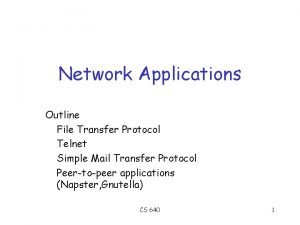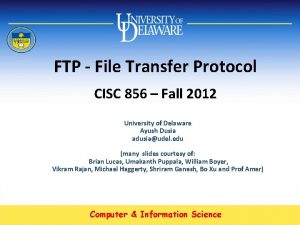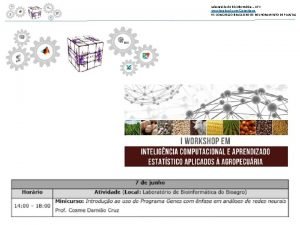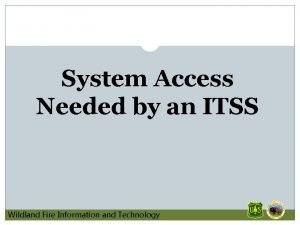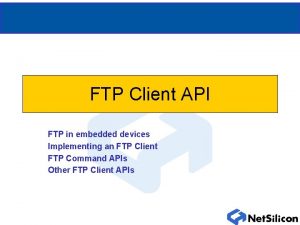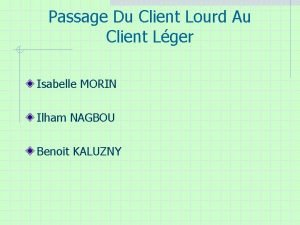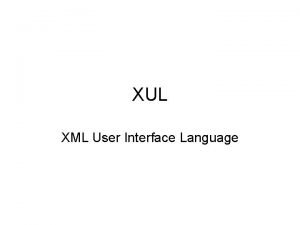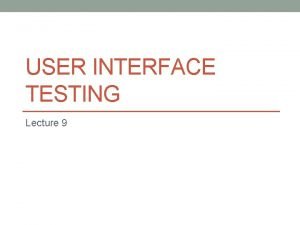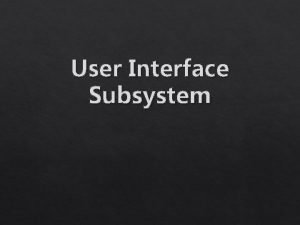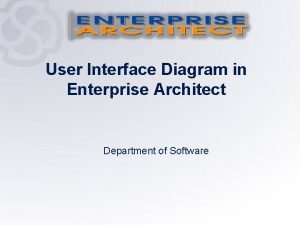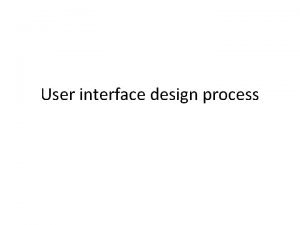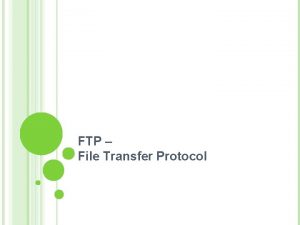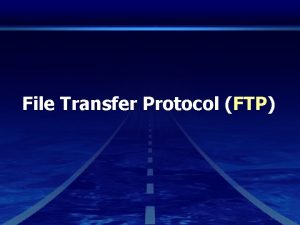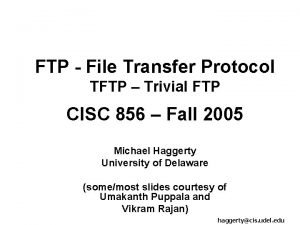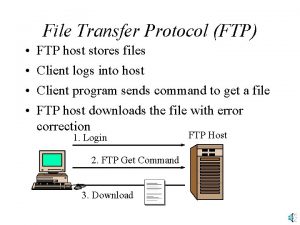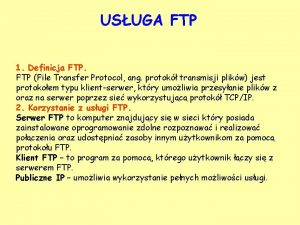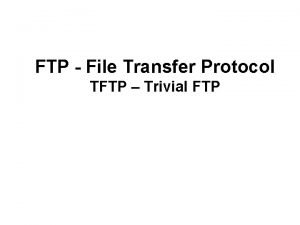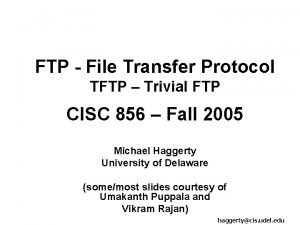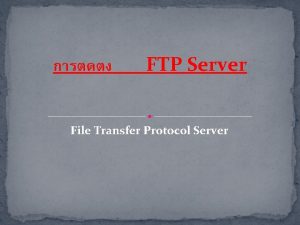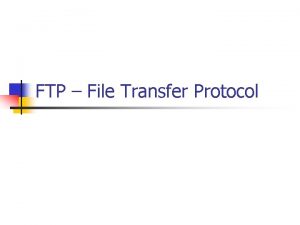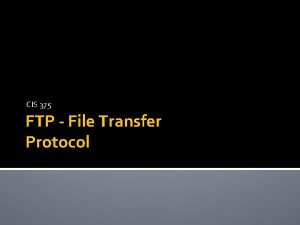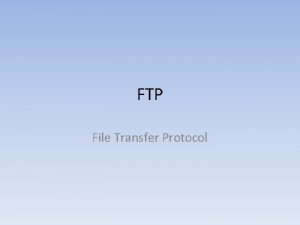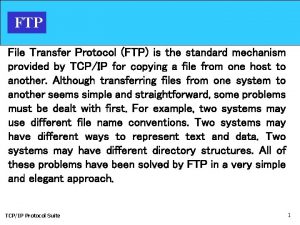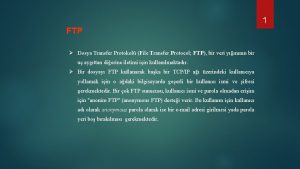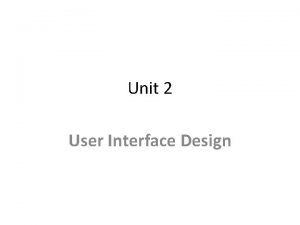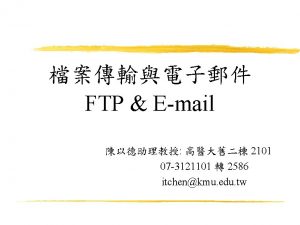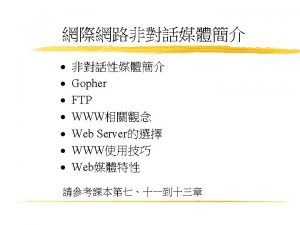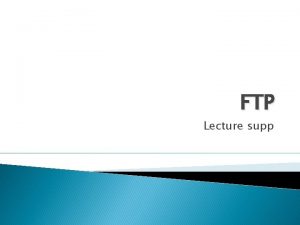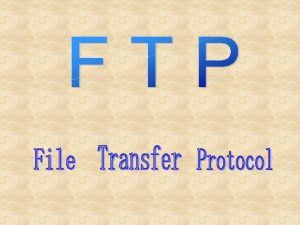ftp File Transfer Protocol FTP user interface client






![Simple Mail Transfer Protocol [RFC 821] Simple Mail Transfer Protocol [RFC 821]](https://slidetodoc.com/presentation_image_h/874c431b12cea59596d6bd16f75a4cdf/image-7.jpg)















![UDP: User Datagram Protocol [RFC 768] v “best effort” service: UDP segments may be UDP: User Datagram Protocol [RFC 768] v “best effort” service: UDP segments may be](https://slidetodoc.com/presentation_image_h/874c431b12cea59596d6bd16f75a4cdf/image-23.jpg)



- Slides: 26

ftp: File Transfer Protocol FTP user interface client user at host local file system file transfer FTP server remote file system v ftp specification: RFC 959 (http: //www. ietf. org/rfc 959. txt)

data connection management

ftp commands, responses over 30 are available v sent as ASCII text over control conn. authentication: user, pass file access: e. g. put, get file transfer control: mode directory: pwd, list, delete ftp session: help, stat, abort, quit Sample commands: v USER username v PASS password v LIST: return list of file in the current directory v RETR filename: retrieves (gets) file v STOR filename: stores (puts) file onto remote host v v v Sample return codes v status code and phrase (as in http) v 331 Username OK, password required v 125 data connection already open; transfer starting v 425 Can’t open data connection v 452 Error writing file

Electronic Mail Three major components: v user agents v mail servers v simple mail transfer protocol(smtp) User Agent v composing, editing, reading mail msgs Ø Eudora, Outlook, elm, Netscape Messenger v outgoing, incoming messages stored on user mailbox user agent mail server SMTP server Mail Servers SMTP v mailbox contains incoming messages (yet to be read) for user v message queue of outgoing (to be sent) mail messages SMTP protocol between mail servers outgoing message queue mail server user agent SMTP user agent mail server user agent

how a sender contacts a SMTP server v an SMTP server process running on every SMTP server host, waiting for incoming mail v TCP port# (25) is permanently assigned to SMTP (“well-known port”) v sender opens a TCP connection to the dest. mailman. cs. ucla. eduapplication layer SMTP server data socket port 25

Email delivery TCP port 25 Your email application program mail server user SMTP agent daemon sender SMTP user receiver user agent User POP mailbox SMTP daemon mail server
![Simple Mail Transfer Protocol RFC 821 Simple Mail Transfer Protocol [RFC 821]](https://slidetodoc.com/presentation_image_h/874c431b12cea59596d6bd16f75a4cdf/image-7.jpg)
Simple Mail Transfer Protocol [RFC 821]

Sample smtp interaction S: 220 hamburger. edu C: HELO crepes. fr S: 250 Hello crepes. fr, pleased to meet you C: MAIL FROM: <alice@crepes. fr> S: 250 alice@crepes. fr. . . Sender ok C: RCPT TO: <bob@hamburger. edu> S: 250 bob@hamburger. edu. . . Recipient ok C: DATA S: 354 Enter mail, end with ". " on a line by itself C: Do you like ketchup? C: How about pickles? C: . S: 250 Message accepted for delivery (if more msgs to send, start from "MAIL FROM" again) C: QUIT S: 221 hamburger. edu closing connection

A typical SMTP message exchange (after the TCP connection setup) sender SMTP process receiver SMTP process 220 whitehouse. gov SMTP ready HELO foo. berkeley. edu 250 whitehouse. gov MAILFROM: <john@foo. berkeley. edu> 250 OK RCPT TO: <clinton@whitehouse. gov> 250 OK RCPT TO: <al@whitehouse. gov> 550 No such user DATA 354 start mail input blah. . . <CRLF> 250 OK QUIT 221 whitehouse. gov service closing

Are there some basic rules behind the reply codes? Code meaning 220 221 250 500 550 service ready I’m closing too requested action OK error, command not recognized no such mbox, no action taken Common practices 1 st digit: whether response is good/bad/incomplete e. g. 2= positive completion, 5=negative completion 2 nd digit: encodes responses in specific categories e. g. 2=connections, 5=mail system (status of the receiver mail system) 3 rd digit: a finer gradation of meaning in each category specified by the 2 nd digit.

smtp: final words v smtp uses persistent connections v smtp requires that message (header & body) be in 7 -bit ascii v certain character strings are not permitted in message (e. g. , CRLF). Thus message body must be encoded if it contains forbidden characters v smtp server uses CRLF to determine end of message Comparison with http v http: pull v email: push v both have ASCII command/response interaction, status codes v http: each object is encapsulated in its own response message v smtp: multiple objects message sent in a multipart message

Mail message format RFC 821: SMTP specification (protocol for exchanging email msgs) RFC 822: standard for text message format: v header lines, e. g. , To: Ø From: Ø Subject: different from smtp commands! Ø v body Ø the “message”, ASCII characters only header body blank line

Message format: extension for multimedia MIME: Multipurpose Internet Mail Extension v additional lines in msg header declare MIME content type MIME version method used to encode data multimedia data type, subtype, parameter declaration encoded data From: alice@crepes. fr To: bob@hamburger. edu Subject: Picture of yummy crepe. MIME-Version: 1. 0 Content-Transfer-Encoding: base 64 Content-Type: image/jpeg base 64 encoded data. . . . . base 64 encoded data

Mail access protocols user agent SMTP sender’s mail server POP 3 or IMAP receiver’s mail server user agent Mail access protocol: retrieval from mail server v POP: Post Office Protocol [RFC 1939] Ø authorization (agent <-->server) and download v IMAP: Internet Mail Access Protocol [RFC 1730] Ø more features, such as msg folders on the server § more complex implementation manipulation of stored msgs on server v HTTP: Hotmail , Yahoo! Mail, etc. Ø

POP 3 protocol authorization phase v client commands: user: declare username Ø pass: password v server responses Ø +OK Ø -ERR Ø transaction phase, v v client: list message numbers retr: retrieve message by number dele: delete quit S: C: S: +OK POP 3 server ready user alice +OK pass hungry +OK user successfully logged C: S: S: S: C: C: S: list 1 498 2 912. retr 1 <message 1 contents>. dele 1 retr 2 <message 1 contents>. dele 2 quit +OK POP 3 server signing off on

telnet (RFC 854) v A TCP connection used to transmit data with interspersed TELNET control information v Client side of the TCP connection initiates a request, the server accepts or rejects the request. v Telnet server uses port# 23 Ø the client side can use any unreserved port. User's key board & display telnet client application process operating system Internet

client-server paradigm v any program can become a network application client when it needs network services v servers are special purpose applications dedicated to providing specific service Ø server processes start at system initialization time v applications at both ends take initiative Ø server application informs local OS that it is ready to take incoming messages § wait for incoming messages § perform requested service § return results Ø client application contacts the server § send request § wait for reply

identifying servers and services v each service is assigned a unique well-known port number v server application process registers with local protocol software with that port # v a client requests a service by sending request to a specific server host with the well-known port # v server handles multiple requests concurrently

Chapter 3: Transport Layer Chapter goals: v Principles behind transport layer services: Ø Ø multiplexing/demultiplexing reliable data transfer flow control congestion control v instantiation and implementation in the Internet Chapter Overview: v transport layer services; multiplexing/demultiplexing v connectionless transport: UDP v connection-oriented transport: TCP Ø How to achieve reliable data delivery v TCP congestion control

Transport services and protocols v data delivery between app’ processes running on different hosts v transport vs network layer services: application transport network data link physical nd network data link physical p ns a tr t or v reliable, in-order delivery(TCP) -e nd Internet transport services: v unreliable, unordered delivery: UDP e al c gi lo network data link physical application transport network data link physical

Multiplexing/demultiplexing Multiplexing data segments from multiple app processes is sent to lower layer for transmission Application data transport header segment Ht M Hn segment P 1 M M application transport network sender P 2 Demultiplexing delivering received data segments to corresponding upper layer protocols/apps P 3 Some other host M M P 4 application transport network receiver

Multiplexing/demultiplexing: examples host A source port: x dest. port: 23 server B source port: 23 dest. port: x Source IP: C Dest IP: B sour port: 2211 dest. port: 80 port use: simple telnet app Web client host A Web clients host C Source IP: A Dest IP: B sour port: 1180 dest. port: 80 Source IP: C Dest IP: B sour port: 1180 dest. port: 80 Web server B port use: Web server
![UDP User Datagram Protocol RFC 768 v best effort service UDP segments may be UDP: User Datagram Protocol [RFC 768] v “best effort” service: UDP segments may be](https://slidetodoc.com/presentation_image_h/874c431b12cea59596d6bd16f75a4cdf/image-23.jpg)
UDP: User Datagram Protocol [RFC 768] v “best effort” service: UDP segments may be lost, or delivered out of order to applications v connectionless: UDP format 32 bits Length of UDP segment (in bytes), including header source port # dest port # length checksum Application data (message)

UDP checksum Goal: detect bit errors (e. g. , flipped bits) in transmitted segment Sender: Receiver: sequence of 16 -bit integers v checksum: addition (1’s complement sum) of segment contents v puts checksum value into UDP checksum field segment v check if computed checksum equals checksum field value: Ø NO - error detected Ø YES - no error detected v treat data in the segment as v compute checksum of received

Internet checksum algorithm v used in IP, TCP, UDP v sender: Ø consider the data block as 16 xn matrix Ø add all data together using 16 -bit one’s complement arithmetic Ø take the one’s complement of the result v receiver Ø add all bytes together, including the checksum field Ø if sum=0, no bit error

checksum computation: Sample code U_short checksum(u_short *buf, int length) { unsigned long sum = 0; if (length % 2) { /* pad the data length to be an even number of bytes */ length += 1; } length >>= 1; while (length--) { sum += *buf++; if (sum & 0 x. FFFF 0000) { /*carry occurred, wrap around */ sum &= 0 x. FFFF); sum++; } } return (~sum & 0 x. FFFF); }
 File-file yang dibuat oleh user pada jenis file di linux
File-file yang dibuat oleh user pada jenis file di linux Ftp protocol in computer networks
Ftp protocol in computer networks Cbre global corporate services
Cbre global corporate services Ftp and tcp/ip
Ftp and tcp/ip Sftp rfc
Sftp rfc Telnet file transfer
Telnet file transfer Purpose of file transfer protocol
Purpose of file transfer protocol Ftp://ftp.ufv.br/dbg/biodata/
Ftp://ftp.ufv.br/dbg/biodata/ Nwcg ftp
Nwcg ftp Ftp client api
Ftp client api Vcloudpoint zero client price
Vcloudpoint zero client price Client lourd vs client léger
Client lourd vs client léger Thin client vs thick client
Thin client vs thick client Skinny protocol
Skinny protocol Interface in interface java
Interface in interface java Office interface vs industrial interface
Office interface vs industrial interface Office interface vs industrial interface
Office interface vs industrial interface Interface------------ an interface *
Interface------------ an interface * Yahoo user interface library (yui)
Yahoo user interface library (yui) What is xul
What is xul Graphical user interface testing
Graphical user interface testing User interface subsystem
User interface subsystem Component diagram enterprise architect
Component diagram enterprise architect Principle of input design
Principle of input design User interface design cycle
User interface design cycle User interface importance
User interface importance User interface design steps in software engineering
User interface design steps in software engineering

